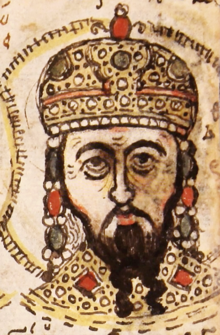| Theodore I Laskaris | |||||
|---|---|---|---|---|---|
| Emperor and Autocrat of the Romans | |||||
 Portrait of Theodore I (from a 15th-century codex containing a copy of the Extracts of History by Joannes Zonaras) | |||||
| Emperor of Nicaea Claimant Byzantine Emperor in exile | |||||
| Reign | 1205–1221 | ||||
| Coronation | 6 April 1208 | ||||
| Predecessor | Constantine Laskaris (possibly) Alexios V Doukas | ||||
| Successor | John III Doukas Vatatzes | ||||
| Co-emperor | Nicholas Laskaris (1208–c. 1210) | ||||
| Born | c. 1175 | ||||
| Died | November 1221 (aged c. 46) | ||||
| Spouses | |||||
| Issue |
| ||||
| |||||
| House | Laskaris | ||||
| Father | Nicholas (?) Laskaris | ||||
| Religion | Greek Orthodox | ||||
Theodore I Laskaris or Lascaris (Greek: Θεόδωρος Κομνηνὸς Λάσκαρις, romanized: Theodōros Komnēnos Laskaris;[1] c. 1175 – November 1221) was the first emperor of Nicaea—a successor state of the Byzantine Empire—from 1205 to his death. Although he was born to an obscure aristocratic family, his mother was related to the imperial Komnenos clan. He married Anna, a younger daughter of Emperor Alexios III Angelos in 1200. He received the title of despot before 1203, demonstrating his right to succeed his father-in-law on the throne.
The Fourth Crusade forced Alexios III to flee from Constantinople in 1203. Theodore was imprisoned by the crusaders (commonly referred to as "Latins" by the Byzantines), but he escaped. After crossing the Bosporus into Asia Minor (in present-day Turkey), he started to organise the local Greeks' resistance against the Latins in Bithynia in his father-in-law's name. He concluded an alliance with the Seljuq sultan of Rum, but he could not stop the Latins' expansion. Neither could he prevent a claimant to the imperial throne, Alexios Komnenos, from establishing a Byzantine successor state, the Empire of Trebizond, in northern Asia Minor. Theodore's position consolidated only after Tzar Kaloyan of Bulgaria inflicted a crushing defeat on the Latins in the Battle of Adrianople (in Thrace) in 1205.
Greeks fleeing from the Latin Empire—the crusader state that emerged in the Byzantine core territories—swarmed to Asia Minor to live under Theodore's rule. The Latins captured Theodore's father-in-law and made an alliance with Alexios I of Trebizond, but Theodore routed their united troops. He secured the support of most Bithynian aristocrats and seized the domains of those who resisted him. In 1205, he assumed the traditional titles of the Byzantine emperors. Three years later, he convoked a Church council to elect a new Orthodox patriarch of Constantinople. The new patriarch crowned Theodore emperor and established his seat at Theodore's capital, Nicaea. The Orthodox population of the Latin Empire regarded Theodore as the main defender of their Church, but the rulers of Epirus—a realm that developed in the western regions of the Byzantine Empire—debated the legality of his coronation.
Theodore's father-in-law did not abandon his claim to the throne. After being released from prison, Alexios III persuaded the Seljuqs to invade Nicaea, but Theodore defeated them in 1211. The Latin Emperor Henry of Flanders captured important fortresses in western Asia Minor in 1212, but he ran out of soldiers and could not place garrisons in them. Henry implicitly acknowledged the existence of the Empire of Nicaea in his peace treaty with Theodore. Theodore conquered western Paphlagonia on the Black Sea coast from Alexios I of Trebizond. Around 1220, Theodore tried to persuade the Latins of Constantinople to acknowledge his rule, but they refused. Theodore established a powerful state, located in the vicinity of Constantinople, which enabled his successors to expel the Latins from the city and revive the Byzantine Empire in 1261.
- ^ Angelov 2019, p. 18.